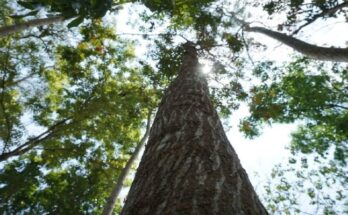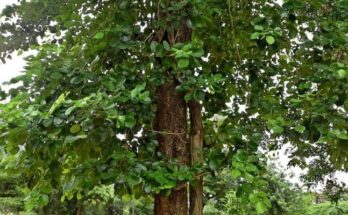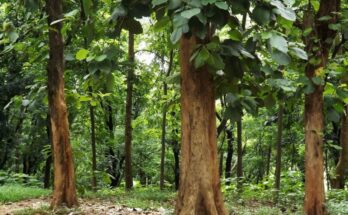|
Getting your Trinity Audio player ready...
|
Rubber trees, also known as Hevea brasiliensis, are fascinating plants with a long and storied history. These trees, which are native to South America, have been used for centuries by indigenous peoples for their latex, which can be processed into rubber. Today, rubber trees are cultivated around the world, from Asia to Africa to the Americas, and their rubber is used in a wide range of products, from tires to gloves to condoms.
One of the most interesting aspects of rubber trees is their biology. These trees are large, reaching heights of up to 100 feet, and they have smooth, gray bark and broad, green leaves. But it is the latex that is produced by the most remarkable tree. Latex is a milky substance that is found in the bark of the tree, and it is extracted by making small cuts in the bark and allowing the sap to flow out.
The history of rubber trees is equally fascinating. The indigenous peoples of South America were the first to use rubber, and they used it for a wide range of purposes, including making shoes and clothing. The first European explorers to encounter rubber were amazed by its unique properties, and they brought it back to Europe to study and experiment with it. By the 1800s, rubber had become a valuable commodity, and countries like Brazil, which had large populations of rubber trees, became very wealthy.
However, the rubber boom did not last forever. In the early 1900s, a British explorer named Henry Wickham smuggled rubber tree seeds out of Brazil and brought them to England, where they were successfully germinated. These seeds were then sent to British colonies around the world, including Malaysia and Sri Lanka, where rubber plantations were established. This led to a massive decline in the price of rubber, and many countries that had relied on rubber exports for their economies suffered greatly.
Despite this, rubber trees remain an important part of the global economy. They are grown in large plantations throughout Southeast Asia and Africa, and their latex is used in a wide range of products. In recent years, there has been increased interest in natural rubber as an alternative to synthetic rubber, which is made from petroleum and can be environmentally damaging.
Rubber trees are also important for their ecological benefits. They are often grown alongside other crops in agroforestry systems, where they can help to stabilize soil, provide shade, and support biodiversity. They are also an important source of carbon sequestration, as they absorb large amounts of carbon dioxide from the atmosphere.
Scientific Classification of Rubber Tree (Hevea brasiliensis)
| Kingdom | Plantae |
|---|---|
| Phylum | Angiosperms |
| Class | Eudicots |
| Order | Malpighiales |
| Family | Euphorbiaceae |
| Genus | Hevea |
| Species | Hevea brasiliensis |
Rubber Tree Care: How to Grow and Maintain a Healthy Plant
Lighting for Rubber Trees: One of the most important factors for the health of your rubber tree plant is lighting. Rubber trees prefer bright, indirect light, but direct sunlight can damage their leaves. If you notice your rubber tree’s leaves turning yellow or brown, it may be getting too much direct sunlight. Conversely, if the leaves are small and far apart, your plant may need more light. Consider placing your rubber tree near a window with filtered light or supplementing it with artificial grow lights.
Watering Your Rubber Tree: Rubber trees prefer to be kept consistently moist, but not waterlogged. Allow the top inch of soil to dry out before watering, and then water thoroughly until excess water drains out of the bottom of the pot. Avoid allowing your plant to sit in standing water, as this can lead to root rot. During the winter months, reduce watering frequency as growth slows down.
Humidity for Rubber Trees: Rubber trees prefer moderate to high humidity levels, so it’s a good idea to use a humidifier or place a tray of water near your plant to increase humidity. Misting the leaves with water can also help, but avoid getting water on the soil to prevent fungal growth.
Temperature Requirements: Rubber trees thrive in warm temperatures between 60-75°F (15-24°C). Avoid exposing your plant to temperatures below 50°F (10°C), as this can cause damage to the leaves and slow down growth.
Fertilizing Your Rubber Tree: Fertilization is important for the growth and health of your rubber tree plant. During the growing season (spring and summer), use a balanced, water-soluble fertilizer every 2-4 weeks according to the instructions on the package. During the winter months, reduce or stop fertilization as growth slows down.
Pruning Your Rubber Tree: Pruning can help maintain the shape and size of your rubber tree and promote new growth. Use sharp, clean pruning shears to remove any dead or damaged leaves or branches. You can also prune back the top of the plant to encourage bushier growth.
Potting and Repotting Your Rubber Tree: Rubber trees prefer to be slightly root-bound, so avoid using a pot that is too large. When repotting, select a pot that is only barely bigger than the existing one. Use a well-draining potting mix and ensure that the pot has drainage holes to prevent water from sitting in the soil.
Don’t Miss: The Ultimate Guide to Corn Plant: Unveiling the Beauty and Care Secrets
10 Interesting Facts about Rubber Tree
- Rubber trees can grow up to 100 feet tall and have a lifespan of 30 to 40 years. They have a forthright trunk with fluffy, gray bark.
- The scientific name for rubber trees, Hevea brasiliensis, comes from the Greek word “heve” which means “to adhere” and the Latin word “brasiliensis” which means “from Brazil”.
- Rubber trees are part of the Euphorbiaceae family, which also includes the cassava and the poinsettia.
- The sap of the rubber tree is called latex, which is a milky fluid that contains a high concentration of rubber particles. It is harvested by making a diagonal cut on the bark of the tree and collecting the sap that flows out.
- Rubber trees were first discovered in the Amazon rainforest by the indigenous people of South America. They used the latex to make waterproof clothing, shoes, and balls.
- In the mid-19th century, rubber became a valuable commodity and demand for it grew rapidly. This led to the development of rubber plantations in Southeast Asia, particularly in Malaysia and Indonesia.
- The majority of rubber production today comes from Southeast Asia, but rubber trees are also grown in other parts of the world, including Africa, India, and South America.
- In addition to rubber production, rubber trees have many other uses. The wood of the tree is used for furniture, flooring, and musical instruments. The leaves can be used for medicinal purposes, and the latex can be used to make adhesives, balloons, and condoms.
- Rubber trees are also important for the environment. They take in carbon dioxide from the atmosphere, aiding in the reduction of greenhouse gas emissions. Additionally, rubber plantations can provide habitat for wildlife, such as birds and insects.
- Rubber trees are a sustainable crop. They can grow on degraded land, and the latex can be harvested without harming the tree. Rubber plantations can also provide employment and economic opportunities for local communities.
10 Uses of Rubber Tree
- Timber: Rubber trees have a straight trunk and produce dense, durable timber that is resistant to rot and termites. This timber is commonly used for furniture, flooring, and construction.
- Biofuel: The bark and wood of rubber trees can be converted into biofuels such as ethanol and biodiesel. This makes rubber trees a sustainable source of energy.
- Shade Trees: Rubber trees have large leaves that provide shade, making them a popular choice for planting in urban areas or as shade trees for crops.
- Medicinal Properties: The latex of rubber trees contains compounds that have been used in traditional medicine to treat a variety of ailments, including fevers, skin diseases, and respiratory problems.
- Landscaping: Rubber trees are often used in landscaping because of their attractive foliage and ease of maintenance. They can be pruned into various shapes and sizes to create unique landscape designs.
- Carbon Sequestration: Rubber trees are effective at absorbing carbon dioxide from the atmosphere, making them an important tool in the fight against climate change.
- Paper Production: The wood from rubber trees can be used to make paper pulp, providing a sustainable alternative to traditional paper production methods.
- Honey Production: Rubber trees produce nectar that bees use to make honey. The honey produced from rubber tree nectar is known for its unique flavor and is highly sought after by honey connoisseurs.
- Edible Oil: The seeds of rubber trees can be pressed to produce an edible oil that is similar in flavor to olive oil. This oil is rich in antioxidants and is a popular ingredient in traditional medicine.
- Water Filtration: The roots of rubber trees have been shown to be effective at removing pollutants from water. This makes them a useful tool in water filtration systems, particularly in areas with high levels of industrial pollution.
Rubber Tree Wood: Properties, Uses, and Sustainability
Properties of Rubber Tree Wood
Rubber tree wood, also known as Hevea wood, is a dense hardwood with a fine, even texture. It ranges in color from light beige to a reddish-brown hue. The wood is resistant to decay and insect damage, making it durable and long-lasting. It is also relatively easy to work with, making it a popular choice for furniture and decorative items.
Uses of Rubber Tree Wood
- Furniture: Rubber tree wood is a popular choice for furniture due to its durability, attractive grain patterns, and ease of working. It finds frequent use in crafting chairs, tables, cabinets, and bed frames.
- Decorative Items: The fine texture and attractive grain patterns of rubber tree wood make it a popular choice for decorative items such as bowls, trays, and vases.
- Flooring: Rubber tree wood flooring is becoming more popular due to its durability and sustainability. It is available in a range of colors and finishes, making it a versatile choice for any interior design.
- Musical Instruments: The dense and resonant properties of rubber tree wood make it an ideal material for musical instruments such as guitars, drums, and xylophones.
- Chopping Boards: The durability and resistance to decay make rubber tree wood an excellent material for chopping boards and other kitchen utensils.
- Construction: Rubber tree wood is a popular choice for construction materials such as beams and planks due to its strength and resistance to decay.
- Paper Production: The wood pulp from rubber trees is used in paper production, providing a sustainable alternative to traditional wood pulp.
- Charcoal Production: The wood from rubber trees is used in charcoal production due to its high calorific value.
- Energy Production: The wood waste from rubber tree plantations can be used as a biomass fuel for energy production.
- Handicrafts: The fine texture and easy workability of rubber tree wood make it a popular material for handicrafts such as carvings and sculptures.
Sustainability of Rubber Tree Wood
Rubber tree wood is a sustainable resource as it is harvested from rubber tree plantations that are managed for latex production. The trees are typically harvested for latex after around 30 years, and the wood is then used for other purposes, providing an additional source of income for farmers. The trees are replanted after harvesting, ensuring a continuous supply of wood and latex. Additionally, rubber tree plantations help to reduce deforestation and provide habitat for wildlife.
Rubber Tree Seeds: Germination, Propagation, and Collection Tips
Germination of Rubber Tree Seeds
Before planting the seeds, it’s essential to prepare them properly for germination. The first step is to soak the seeds in water for 24 hours, which helps to soften the outer layer and encourage sprouting. After soaking, you should remove the seeds from the water and place them in a moist, warm location for a few days to promote germination.
Once the seeds have germinated, they can be planted in a pot or directly in the ground. Plant the seed about 1 inch deep in the soil, and make sure to keep the soil consistently moist but not waterlogged. It’s important to place the pot or seedling tray in a warm, humid location to promote growth.
Don’t Miss: Chinese Money Plant, Care, Benefits, Flowers & Propagation
Propagation of Rubber Tree Seeds
In addition to germinating seeds, rubber trees can also be propagated through cuttings. To propagate a rubber tree from a cutting, start by selecting a healthy stem that is at least 8 inches long. Cut the stem at a 45-degree angle, making sure to use a clean, sharp knife.
After cutting the stem, remove any leaves from the lower portion of the stem and dip the end in rooting hormone. Then, plant the stem in moist potting soil and cover it with a plastic bag to create a humid environment. After a few weeks, the cutting should begin to root and can be transplanted to a larger pot or directly in the ground.
Collection Tips for Rubber Tree Seeds
If you’re interested in collecting rubber tree seeds for germination or propagation, there are a few tips to keep in mind. The seeds should be harvested when they are fully mature and have turned brown. You can collect the seeds directly from the tree or fallen seed pods on the ground.
After collecting the seeds, it’s important to clean and dry them thoroughly before attempting to germinate or propagate them. Keep the seeds in a cool, dry location until you’re prepared to utilize them.
Conclusion
Rubber trees are a versatile and fascinating plant with a long and storied history. They have played an important role in human society for centuries, and they continue to be an important part of the global economy and the natural world. Whether you are interested in the science of plant biology, the history of human exploration and discovery, or the economic and environmental implications of global trade, rubber trees are a topic worth exploring.
Don’t Miss: Cherry Tree | Facts, Benefits, Cultural Significance, Varieties, & How to Grow



